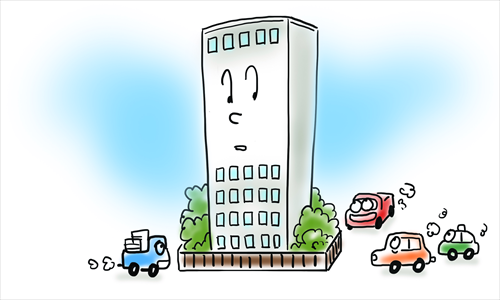HOME >> OP-ED
Roads widen as compound gates come down
Source:Global Times Published: 2016-2-24 21:38:01
Street and block will open up tight cities

Illustration: Liu Rui/GT
Editor's Note:
A government decision to open up the enormous numbers of gated residential compounds to ease traffic congestion has triggered a public uproar online. "No more enclosed residential compounds will be built in principle," the directive issued by the Communist Party of China Central Committee and the State Council instructs. Many residents are concerned about personal and property safety risks caused by the order. The Global Times has collected three pieces over this matter.
Instead of blaming private cars, the public, including professionals, attributes traffic congestion to unreasonable urban planning. Sprawling gated residential compounds are the main reason for low road density in many cities. From a professional perspective, removing walls from residential complexes to ease traffic is undoubtedly logical.
However, in addition to professional knowledge, policymaking has to take many other elements into consideration. First, gated residential complexes need to be regulated. Although as many economists point out, the formation of urban structure is endogenous, exogenous policies can exert significant influences over, and sometimes are of vital necessity for urban structure. For instance, while enjoying an enclosed environment, residents have not paid the costs for exterior traffic congestion caused by these enclosures.
In addition, the guidelines need to consider the obstacles in opening up the gated residential compounds. Following the introduction of the street-and-block system, property rights will witness major changes. Plus, many old residential districts have no underground parking facilities. The community's interior roads, which serve as parking areas as well, will have limited effect on diverting traffic flows.
The government can save substantial administrative costs by banning new enclosed communities. Yet most of the newly built compounds are located on the outskirts of cities. Despite its positive role in preventing traffic congestion from deteriorating, the effects of the ban on improving traffic hinges on the location of the communities.
Furthermore, policymakers need to understand that, despite the help of GPS, drivers' ability to search for the newly created community roads will be greatly restricted by the costs of changing routes. Even the big data navigation systems have a limited capability to search for interior roads within the compounds. It is an extremely tough task for drivers to calculate their routing based on the feedbacks from the navigation system.
Therefore, it is one-sided to simply praise or criticize the street-and-block system. As a top-level design, the guidelines may have both negative and positive effects. The performance of the system depends on the details in implementing concrete policies. This requires professional suggestions from urban design researchers. Expanding political wisdom to other areas is of significance as well.
guancha.cn
Posted in: Viewpoint